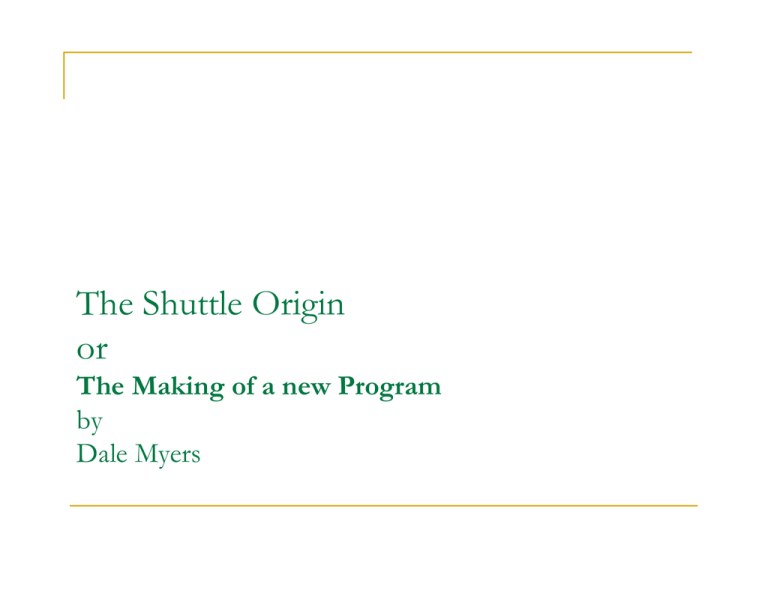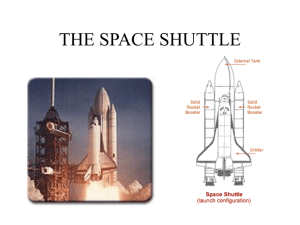The Shuttle Origin or The Making of a new Program by
advertisement

The Shuttle Origin or The Making of a new Program by Dale Myers Pre Lunar Landing Planning 2/61-10/68 Jim Webb didn’t want future plans—wanted to keep options open 3/69-9/70 Tom Paine never saw a future plan he didn’t like 1/64-10/68-Lots of lifting body work 10/68-early 70 NASA dreamed of ever increasing budgets, and planned accordingly Initial Public Awareness 1969 Agnew Study- with Bob Seamans, Tom Paine, Lee Dubridge Supported by NASA’s ideas 30 ft Diameter, 12 man Space Station 2 in earth orbit, one in Lunar orbit Lunar Base Two stage fully recoverable Shuttle 100-150 flights per year SkyLab with 5 visits by Command Modules Continue Saturn 1b and Saturn V production Space tug for higher orbits than LEO Nuclear stage for Moon and Mars Mars program by 1983 Meanwhile, the Budget Crash Euphoria of 1968 followed by severe cuts Vietnam, Great Society budget deficits were causes, Nixon not a big supporter 1966 MSF budget=$3.8B, 1972=$1.7B Was there going to be a human space program at all? Mueller leaves in late 1969 Paine leaves in late 70 (Low acting Admin.) Myers (1/70) and Fletcher (4/71) NASA Strategy-1970 Shuttle is first priority, because low cost to space will encourage all the Agnew Report items later Start 2 stage Shuttle Phase B, and Cancel Apollo 18 and 19 and Saturn 1b and V Cancel 2nd Skylab and CSM’s Cancel 30 ft. Space Stations Don’t start Space Tug Don’t start Nuclear Stage Cancel Mars program Industry down from 400,000 to 150,000 The Concept for a Shuttle Reusability equals low cost “you wouldn’t fly to New York and throw away the airplane” Since R & D is higher, need many flights to beat ballistic systems The lower the R & D the less flights needed to beat ballistic systems If flights are many (because cost/flight is so low) a two stage, fully reusable system is right The Technology Development 1950-1970 Burnelli lifting body X-20 Dynasoar delta wing HL-10 Lifting body X-24A-Lifting body X-15-Winged, internal fuel X-15-Winged, internal and external fuel Navaho M=3 parallel tank separation Burnelli Lifting Body Evolution of the Shuttle 1969-1971 Fully reusable two stage Straight wing, like an X-15 Internal fuel Metal shingles (or unobtainium or some ablative) 20000 lb. payload, due east Payload bay 12X40? 400 miles crossrange 100 to 150 flights/year $5 Million/flight in 1970 dollars Meanwhile, the Mission Model When the Space Station, lunar base, etc. disappeared, we needed more payloads (50+/year) Military agreed to put all payloads on Shuttle if we increased payload and designed for 1500 miles of crossrange, and met our cost/flight estimates. Commercial agreed to carry all payloads on Shuttle (assumed we would develop a low cost upper stage and meet cost/flight estimates). Science bought space servicing (i.e. Hubble) and a low cost reusable platform Evolution of Requirements (mostly from Military Requirements) Payload increased to 40,000 lbs Polar Crossrange increased to 1500 miles Payload bay increased to 15 by 60 Non ablative reusable thermal protection Two fully recoverable piloted stages Automatic checkout and 30 day turnaround Evolution II Phase B showed Development of two stage fully recoverable Shuttle costs $14B for R&D Nixon says “Build any shuttle you want as long as it doesn’t cost more than $5B” OMB says “make it cost effective” NASA looked for alternatives with new Phase A Single Stage to orbit Trimese X24B surrounded with tanks External Orbiter tanks Parallel or series booster The Mathematica Study To convince OMB, Nixon and Congress We hired Mathematica to do cost effectiveness study Results showed today’s configuration best Delta wing for crossrange Weight increase for military payloads 15 x 60 payload bay (15 for Space Station, 60 for military) 40,000 lb. payload, polar Parallel External throwaway monocoque tank 2 Recoverable, abortable solids Liftoff thrust augmentation with engines in Orbiter Resulting Program Nixon Start on Jan. 5, 1972 5 Orbiters Reusable Orbiter and engines, reusable solid cases, expendable fuel tank 40 to 50 flights per year $10M-$15M per flight in 1970$ $5.2B+20% reserve for R & D in 1970$* • • *As soon as Nixon left office, OMB forgot the 20% reserve NASA Comptroller (pressed by OMB) didn’t agree to 1970 base Design Issues Straight vs Delta wing External vs internal tank(s) Start on ground safer, better performance Staged combustion better performance Retractable turbojets Solids looked more reliable and cheaper R&D Engine location and type Ceramic tiles, carbon-carbon and blankets Solids or liquid booster External much lighter. Fuel transfer difficult Thermal Insulation Delta wing required for crossrange No--Depend on low L/D landings Series vs parallel boosters Series heavy, less performance Design Issues cont’d 2 Solids vs. 1 or 2 Liquid strapons Two solids could be shipped by rail Solids had a better reliability record Solids could be recovered (industry studied pressure fed) Designers thought they could turn off solids. Thermal Insulation Later found they could not Ceramic tiles, carbon carbon, and external insulation blankets (all new) High pressure staged combustion engine (new) Crew escape. (Only with complete structure) Operations Costs Operations Costs Enormous confidence from the Apollo program Studies by American Airlines, IDA and the Aerospace Corporation nearly confirmed NASA operations costs NASA thought they had enough reliable, space based hardware in the industry to support quick turnaround, easy to maintain hardware NASA did not properly account for costs associated with: Post flight maintenance Assuring safety of flight in a hostile environment Difficult cutting edge technology (Engine and Thermal) FO/FO/FS Cost tradeoffs between R & D and Operations Operations Cost In 1970, $10M/flight price was based on same accounting system used for Apollo-hands on only, with a separate account for overhead. With $400M/year overhead, and inflation according to the consumers price index, cost per flight would be: 1970 40 flts/year, no overhead $10M 40 flts/year, include ovhd. $20M 8 flts/yr, include overhead $60M 1981 $23M $45M $135M 2005 $50M $101M $302M Shuttle Performance The Shuttle has done everything it was designed to do. It has delivered Military, commercial, and scientific payloads to LEO and GEO, retrieved and replaced satellites, repaired spacecraft, and launched elements of the Space Station In the 80’s, shuttle had 4% of launches, 41% of mass launched Shuttle R&D was within what Nixon and Fletcher agreed. ($5.2B +20% reserve in 1970$) Missed two key design issues (cold O rings and foam shedding) Missed operations costs. A two stage reusable system would have missed worse. Spacecraft are not “like an airplane”. Spacecraft are not like Airplanes Every flight is a “structural dive demo.” No reusable space system gets millions of hours of stressed operation No reusable space system develops decades of evolutionary model improvement Every reusable system is exposed to enormous environmental variations Thermal, vibration, pressure, Mach Number So, for the next program Keep it simple. Don’t stretch the technology Use good margins of safety Keep it as small as possible Carry as few passengers as possible Carry people or cargo, not both Keep requirements to a minimum Use as many past components and systems as have been proven reliable Design for operations Easy access, one man can replace boxes, etc. Keep a program design reserve to reduce Ops. costs

